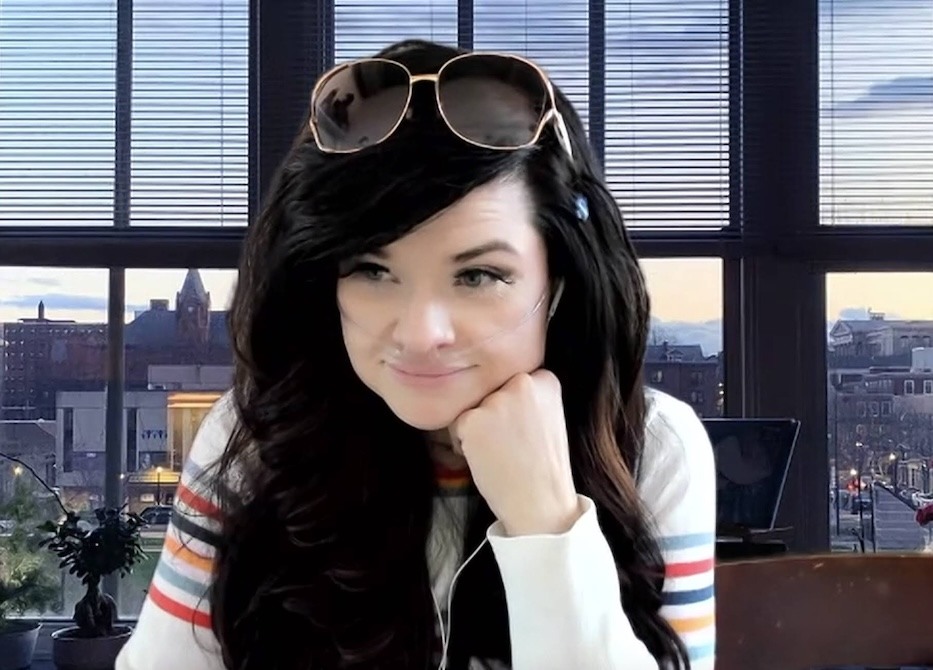
Culture & Community | Film | Arts & Culture | Visual Arts | Graphic Design
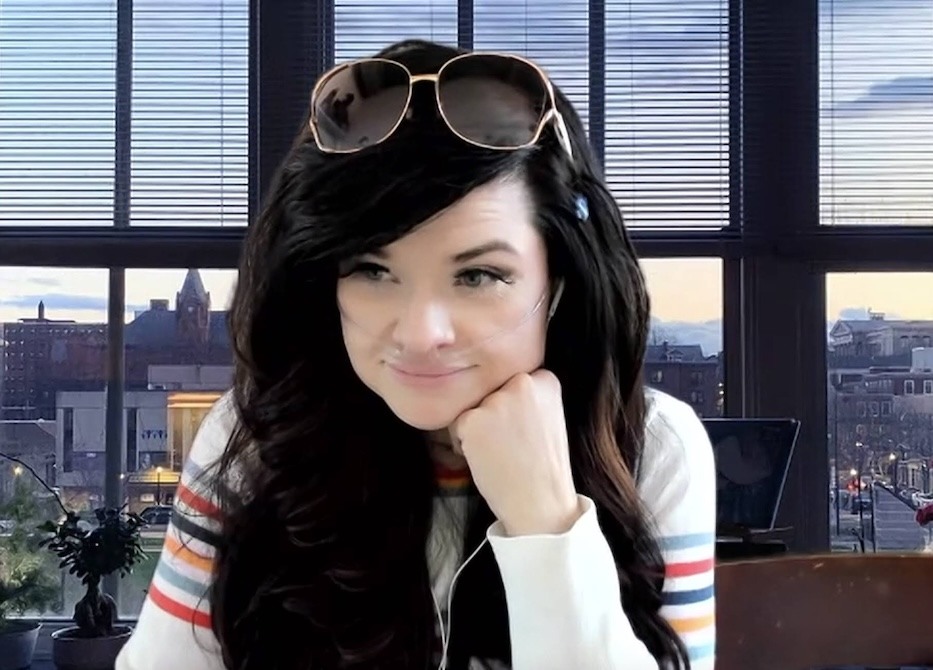
Kelly Bigelow Becerra during a Zoom call with the Arts Paper.
Kelly Bigelow Becerra is working hard on the project of a lifetime—but her deadline is harder than most and approaching fast. She has to get it done before she dies.
The New Haven-based artist is the creator of the ubiquitous “Made in New Haven” logo that launched a 2016 campaign to promote goods that were created here in the city.
She’s working to catalog all her art–visual art and films–and use it to set up The Kelly Bigelow Becerra Foundation for the Arts, an organization that will preserve her work and serve young artists in rural areas. Becerra, 48, has a rare terminal cancer that causes her intense pain and cannot be treated by chemotherapy or radiation.
“People are impressed,” she said. “They ask how I’m doing this. What am I supposed to be doing with my time right now? I’m so afraid that if I stop, that’ll be it.”
Becerra has turned her fear into motivation to help young artists from rural communities like the one she grew up in have the kind of career she’s had. Spanning three decades, Becerra’s career has catapulted her to international stages. She has a lot of wisdom to share before her time runs out.
A Country Girl Makes Good
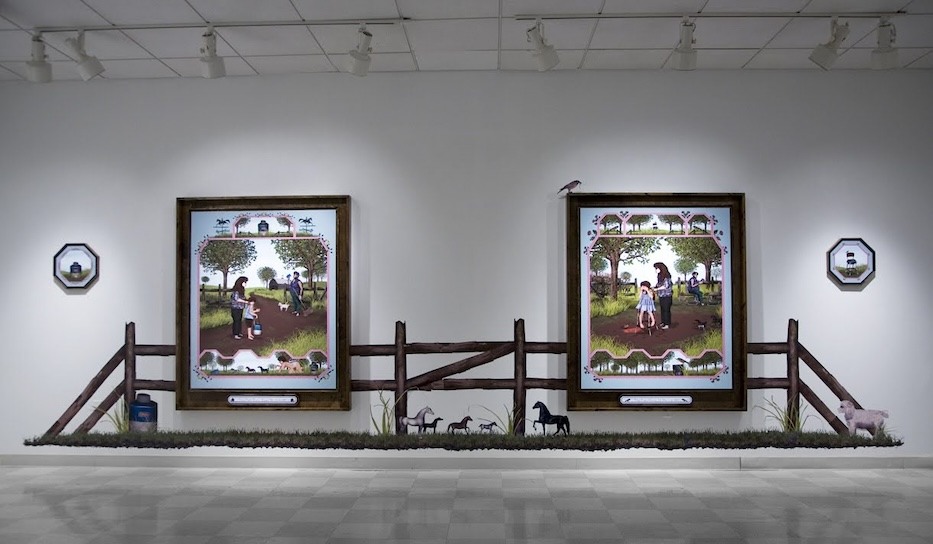
Becerra's work. Photo courtesy of the artist.
Becerra knows a lot about working hard, but prior to cancer those efforts were mostly aimed at her artistic endeavors.
An alumna of the Cleveland Institute of Art and graduate of the School of the Art Institute of Chicago, Becerra has received numerous grants and exhibited widely. She also is an experimental independent filmmaker whose films have been shown at film festivals all over the world, including Sundance, and screened during the Cannes Film Festival.
She ended up in New Haven after being accepted to Yale for graduate school, though she ended up not attending because she couldn’t afford it.
Her life as an artist has taken her far from the tiny town of Jonesville, Mich. where she grew up.
“My first home was a trailer in a cornfield,” Becerra said. “My work deals with both the idyllic and the hard stuff of growing up in a very small town.
“It was idyllic, even though not great things happened to me,” she added, referring to the violence and abuse she experienced as a child. “Going through trauma is terrible and I wouldn’t recommend it to anyone. But I was always going to be plucky.”
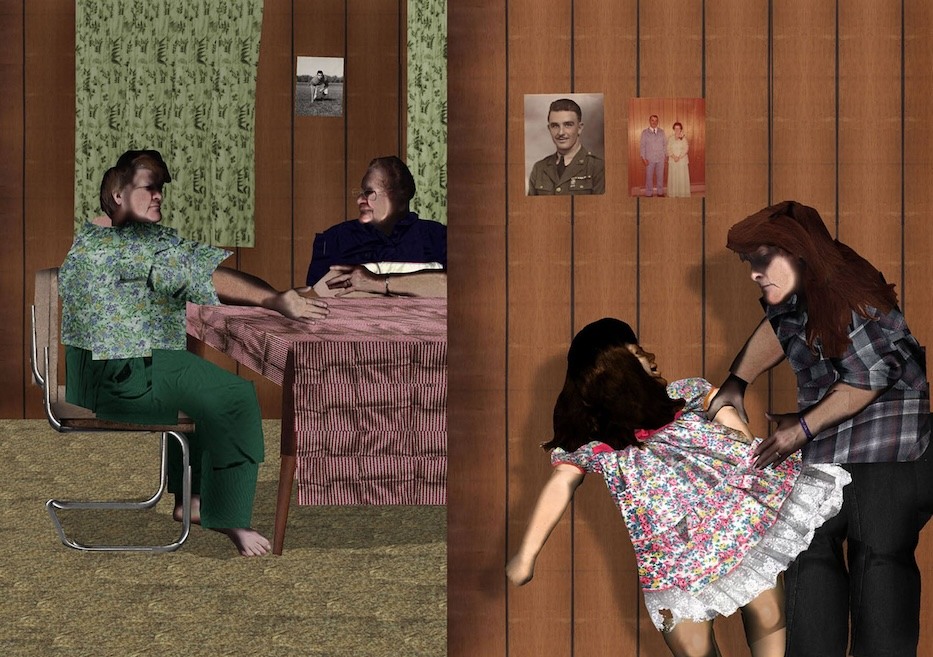
Di Hurting Little Kelly. Image courtesy of the artist.
Becerra became a pioneer in the digital arts in the 1990s, among the first people to use a scanner as a camera.
“There were cameras, but we had to pay for film developing,” she said. “It cost money and time. There were digital cameras, but they were expensive and no one had them. “
She said she figured out that a scanner could act as a camera.
“I love the odd flatness and foreshortening that happens with the scanner … like pressing flowers into a book as a keepsake, I ‘pressed’ and recorded things and people from my childhood,” she said. “I also had this idea when I first started scanning, that the dysfunction of my relatives would show on the surface and that the one to one direct contact with the glass of the scanner would capture it.”
Becerra’s work is inspired by early American samplers where a girl would demonstrate her skills to show her worth, she said.
“I 'stitch' together my digital collages of scans to create images that are both nostalgically romanticized and traumatically factual, depicting a time when my own worth was not valued,” she said.
“A friend once said to me that the way I make efforts to ensure people around me feel seen, loved, and heard–and just how big my presence is–is directly related to how small, unseen, and unloved I was made to feel as a child,“ Becerra added. “That is the way I've tried to approach my whole life. That is why I am approaching the foundation this way.”
“Art saved me,” she said. “I want to try to give kids the same opportunity to save themselves."
A Lesson Before Dying
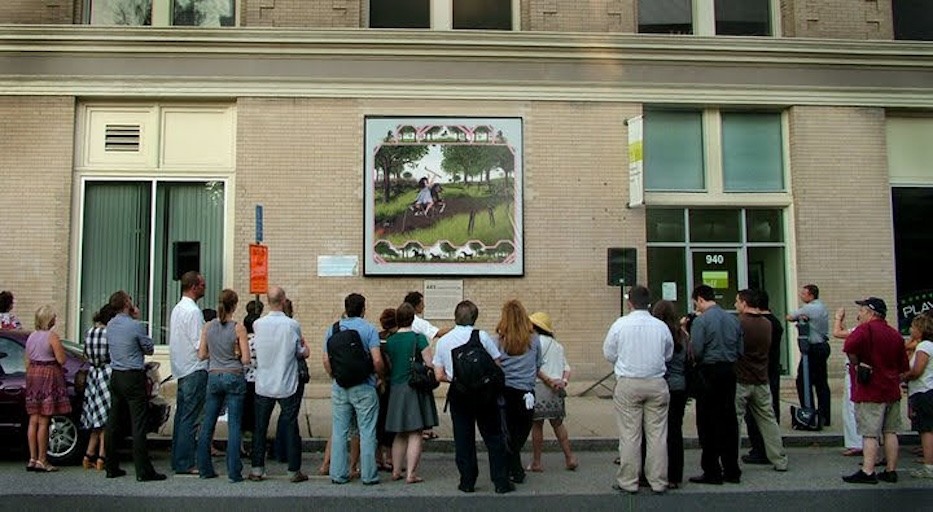
Image courtesy of the artist.
When her cancer was first diagnosed, Becerra’s life didn’t change much at first, she said. She didn’t tell many people about how bad things had become until she had to wear oxygen.
Becerra is now in hospice care because she is no longer a candidate for more procedures. Radiation and chemotherapy don’t work on her cancer, which is why she still has all her hair. She said she relies more and more on others, especially friends who have turned into her chosen family.
Her good friends, Kate Wagle Hitmar, who she met in art school and Anna Mariotti, who she worked with in New Haven, say that she lights up a room when she enters and that she’s always looking for where to find joy.
Hitmar said that when they were younger, friends gave Becerra the moniker “Art Star Kelly,” because she especially lights up when she talks about her art and art in general. Becerra now uses it as her Instagram handle.
Becerra has to spend a lot of time alone because of her compromised immune system, but friends like Hitmar and Mariotti are constantly close, often by phone or video chat.
“I have friends involved that I have known since high school and haven't talked to in years,” she said. “Yet my experience has been that people are happy that you are giving them the chance to help. I just wish I had asked for help sooner.”
Becerra said she believes that if a person makes art, no matter how much or little, they should also make time to think about its future. She said artists are not valued, so they have to value themselves and each other.
“When I started the process of preserving my work, there were people who said because I wasn’t exactly prolific they didn’t know how to help,” she said. “It took other people, like Kate and Anna, to say ‘Of course your work matters.’ Due to circumstances of my life, I didn’t push my work into museums; it doesn’t mean it wasn’t important.”
Becerra is also open about the financial struggle of living, and of dying, as an artist. She said money is an issue because many artists are just trying to make ends meet and can’t afford to hire legacy planning experts to help. Artists also can’t often afford to take time away from making money to catalog their work.
“Even being cremated costs money,” she said. “It’s $1,500 just for basic cremation and a basic funeral is $3,000. We’ve just all been priced out of dying.”
“It’s disgusting and vile to me that people who are dying have to worry about a place to live,” Mariotti said. “Gofundme is America’s de facto health care plan or support plan.”
(You can support Kelly Bigelow Becerra here.)
“It’s true,” Becerra co-signed. “I won the worst lottery on the planet. When people have terminal cancer they shouldn't have to pay rent.”
“There’s such a wealth gap between maker and buyer,” Mariotti said. “Kelly’s experience and willingness to talk about it illuminates this social issue in a human way. I hope this article will help start a conversation.”
Becerra’s Guide to Preserving Your Art
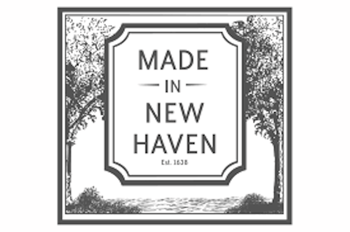 Becerra said she’s not been a model artist and that she’s having to do some huge catch up.
Becerra said she’s not been a model artist and that she’s having to do some huge catch up.
“If I can do anything for other artists, it’s to tell them to start attending to the business of their art earlier,” she said of legacy planning. “You don’t want to do it the way I’m doing. I’m stressed every day. You don’t want to be doing it in pain and sick.”
Artists pay rent, make art, do stuff, she said. What happens when they die is not something they want to think about. But one of the first things she learned about artist estate planning is that a lot of art inevitably ends up in a Goodwill, at an estate sale, or in the trash. Just making a will is difficult, she said.
“A lot of artists have collections of work by other artists,” Becerra said. “Because they trade and barter. If you own the work of other artists, you can protect that work too.”
Becerra recommends:
- Keep track of your art. There are apps that make things easier for artists to keep their archives, like Artwork Archive. It helps you stay organized and is a place you can direct people to see your body of work.
- Let your loved ones (and buyers) know what your wishes are for your artwork. Give them a list, and/or create a simple will, to let them know what to do with your art, as well as art you’ve collected.
- If you sell work, in a gallery or otherwise, keep track of who bought your pieces, so you can circle back to them if you want to have the work in a book or be in a show.
- Have a mailing list. Reach out to people. Stay connected.
- Make a little time for the business of your art regularly; make it a part of making your art.
- Get together with an artist friend or a small group and do this work together.
Becerra also suggests that artists connect with organizations that support them. For example, Tamara Dimitri, public art & grants program specialist and accessibility coordinator at the Connecticut Office of the Arts, has worked with Becerra for 15 years and has been an important member of her team.
Dimitri was able to connect Becerra with Volunteer Lawyers for the Arts, which helped her work with an affordable attorney who helped her sort through legal issues around her own work and a collection of work by other artists that she owns. They also helped her create the legal framework for her foundation.
Dimitri, an artist herself, also recommends the following resources for artists who want to continue their legacy work:
- A downloadable workbook for artist estate planning: https://www.joanmitchellfoundation.org/estate-planning-for-visual-artists
- Planning your legacy: https://portal.ct.gov/DECD/Content/Arts-and-Culture/Programs_Services/Volunteer-Lawyers-for-the-Arts/Workshop-Archive
- The Joan Mitchell Foundation: https://www.joanmitchellfoundation.org/guides
As Becerra scrambles to put her personal and artistic affairs in order, she’s focused on communicating what she’s learning because she’s clear that it’s not always how you start, but how you finish.
“There are days when I don’t want to get dressed,” she added. “I try really hard not to let too many of those days stack up. I don’t want to go anywhere. But since I have to, I want my life to have something to give. I want to do all these things that the foundation will do in my name. I’m just working really hard to not have it fall apart when I’m not here.”
She is working really hard. Her enthusiasm and dedication, not her pain, is what comes through.
“I don't know how to be any different,” she said. “I got shiny today. It’s a lot of work; I don’t get this shiny every day.”
She paused and said, “It’s hard for me to say I’m shiny. Please say I’m shiny.”
Kelly Bigelow Becerra is shiny. She’s an absolute art star.

